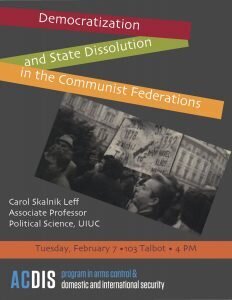
Lecture with Carol Leff
On February 7, 2017, Professor Carol Leff gave a lecture titled “Democratization and State Dissolution in the Communist Federations,” to help answer whether partition can be a solution to ethnic violence. Using the examples of Yugoslavia, Czechoslovakia, and the USSR, she discussed how the collapse of communism contributed to the dissolution of these countries, and how free elections in tandem with ethnic grievances brought about separationist attitudes that shaped the countries we see today.
Dr. Leff began the lecture by considering the relationship between definitions of partition and secession. Partition, she said, is “the creation of an international dividing line between two or more antagonistic groups,” which can be drawn based on identity, ideology, or politics. The division of territories can either be by lines on a map or physical barriers. This definition is not universally used. For example, Sambanis qualifies partition “as an outcome that involves both border adjustment and demographic changes,” while Kaufmann describes it as “separations jointly decided upon by the responsible powers…Or imposed on both sides by a stronger third party.” Applied to real-world examples such as the Nagorno-Karabakh region in Azerbaijan or the Abkhazia and South Ossetia regions in Georgia, it is hard to define whether partition has formally taken place, since some lands are occupied by one party or blocked off without permission from the other, or territorial boundaries are not recognized by all parties.
There are a number of factors that may contribute to efforts at partition and/or secession (i.e. partition without mutual agreement). Professor Leff cited decolonization, regime change, and civil war as examples. However, the most common type of war, ethnic war, often brings about consideration of secession. This trend was especially visible in the 1990s as communism was collapsing throughout the former Soviet Bloc and credible independence movements spiked. As communism fell and democracy was allowed, republics in the existing ethno-federations began to form segmented party systems and compete politically.
In Czechoslovakia, “federal and Republic-level elections created constituencies for national self-assertion and divergent agendas.” Since Czech and Slovak leaders could not successfully bargain over the formation of a single democratic state, deadlock drove the republics to act as separate entities. As a result, protests took place when people feared that not all would be equally treated in a federation governed by Prague. However, an independence movement never took place. The vast majority of Czechoslovakians wished to continue as a single entity. Despite this, in the 1992 election, the Czech Republic and Slovakia peacefully became independent states. Partition helped solve political deadlock, and even today, Dr. Leff pointed out, “Slovaks and Czechs then and now consider each other the most favored ‘other’.”
In Yugoslavia, the deadlock was an issue among the republics before the democratization of the region. Unlike in Czechoslovakia, groups in Yugoslavia used democracy as an instrument to legitimize independence movements. While Croatia and Slovenia were having democratic elections, the other areas remained authoritarian, pulling apart the Yugoslavian Communist Party. Ethnic grievances arose as republics with divided political systems and stances on secession fought over the future of Yugoslavia. Today, “cross-border tensions continue as does the frozen state of the Bosnian Dayton Framework” (named after a peace agreement reached in a city in Ohio).
The Soviet Union broke up in 1991 as a result of decentralization under Gorbachev, economic reform failure, ethnonational defection, and military refusal to use repression. Events that led to the dissolution of communism and the USSR include Novo-Ogaryovo Treaty Negotiations, the coup against Gorbachev in an attempt to re-centralize the USSR, the Baltic states leaving the Union, Ukraine’s referendum for independence, and the Minsk Accords on the secessionist movement in eastern Ukraine. Whether or not the USSR’s case of partition was a solution to violence, Professor Leff left open to question, citing Russia’s relations with Ukraine, Georgia, and Nagorno-Karabakh for reference.
“Scholars do not agree on the viability of partition as a conflict solution,” Professor Leff concluded. Statistical answers to the partition question vary based on how partition and success are defined. The separations in Czechoslovakia, Yugoslavia, and the USSR can all be interpreted as more or less successful depending on the desired goal.